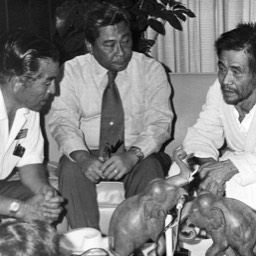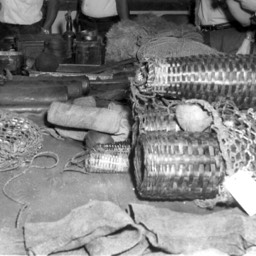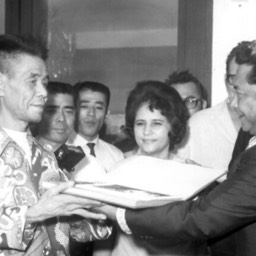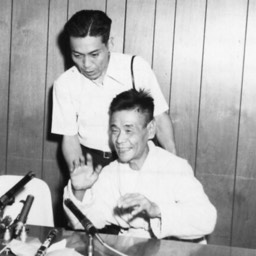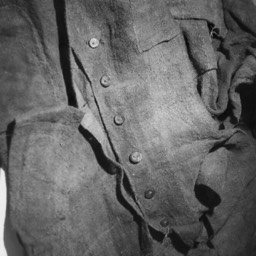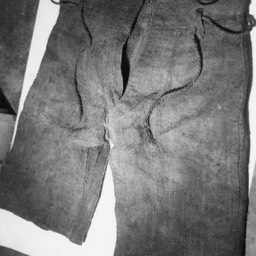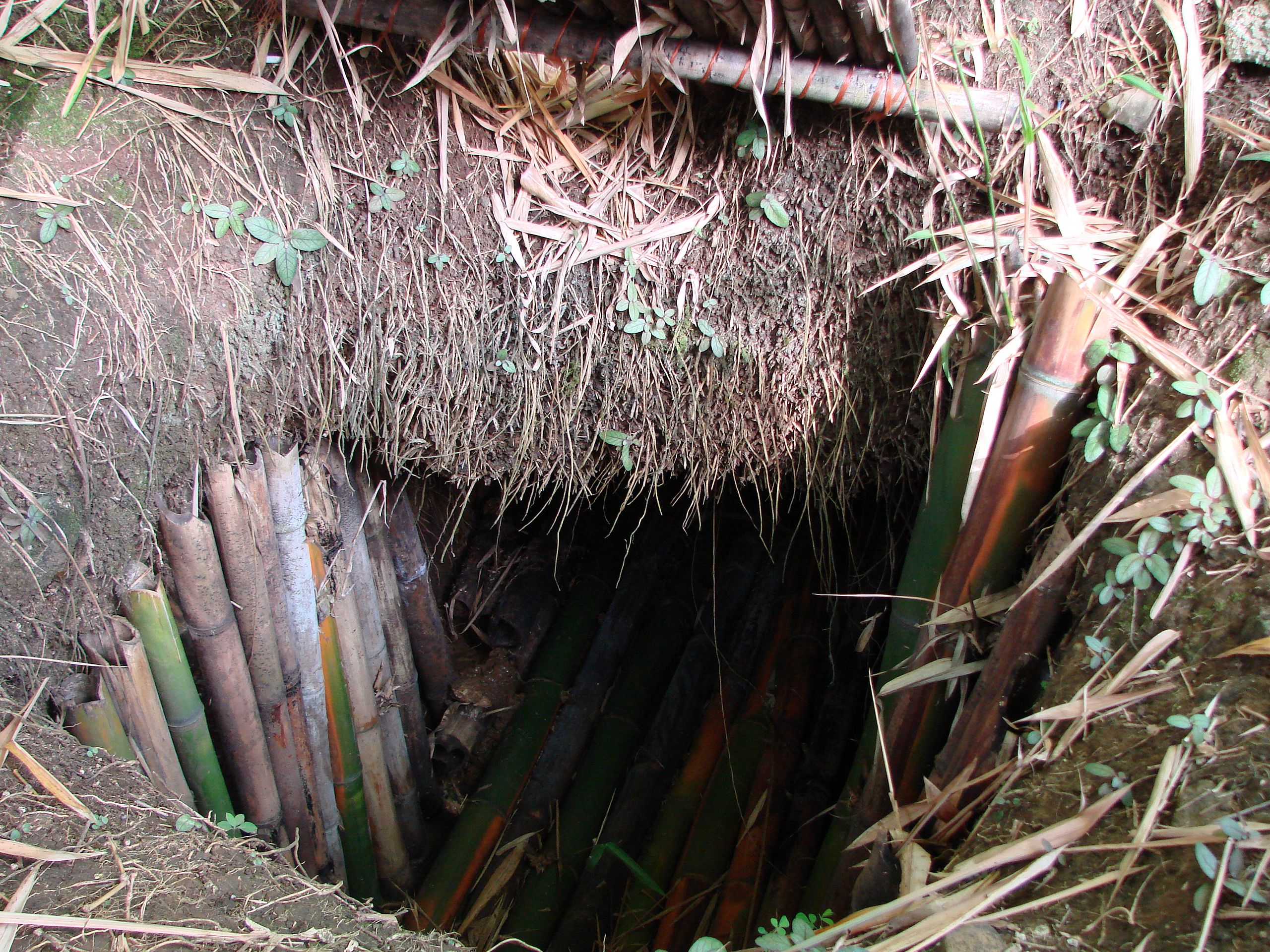

Last Straggler on Guam


Sgt. Shoichi Yokoi, Last Japanese Straggler on Guam
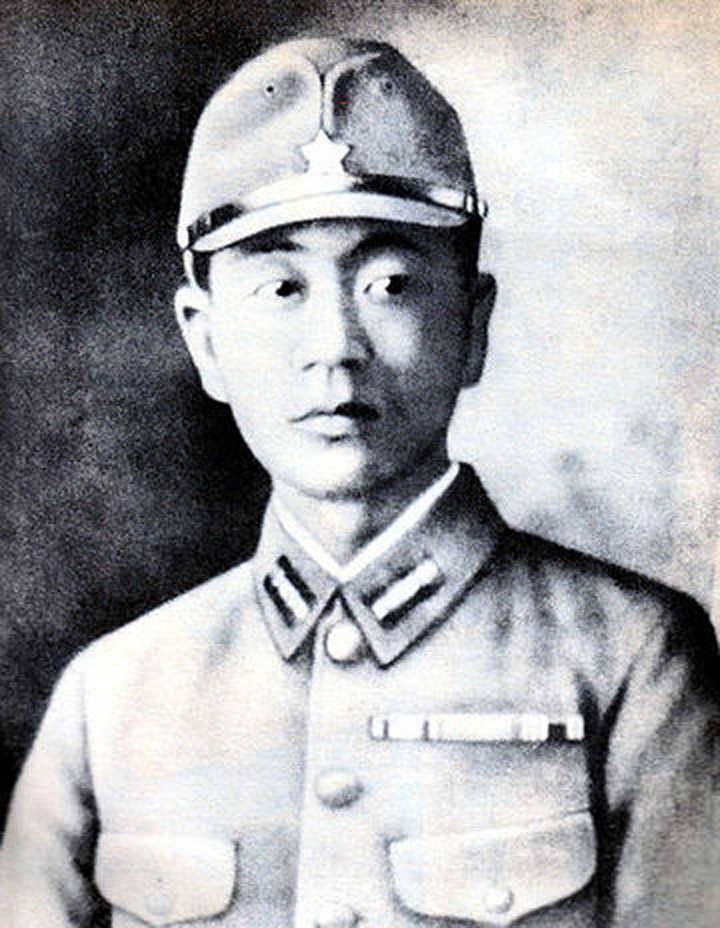
Sgt. Yokoi Shōichi
Yokoi Shōichi, March 31, 1915 – September 22, 1997) was a sergeant in the Imperial Japanese Army (IJA) during the Second World War, and was among the last three Japanese holdouts to be found after the end of hostilities in 1945. He was discovered in the jungles of Guam on 24 January 1972, almost 28 years after U.S. forces had regained control of the island in 1944.
Hid in Guam jungles
Shoichi Yokoi (1915 – 1997) was a sergeant in the Imperial Japanese Army, stationed on Guam during the Japanese Occupation of the island during World War II (December 1941- July 1944). Yokoi is best known as one of the last surviving stragglers from the war, having remained hidden in the jungles of Guam for almost 28 years.
Assignment on Guam
Yokoi was born 31 March 1915 and was raised in the city of Nagoya, Saori, Aichi Prefecture in central Japan. He worked as an apprentice tailor when he was drafted into military service in 1941. Yokoi served in the 29th Infantry Division which was sent to Manchuko (Manchuria) in northeastern China. He was later transferred to the 38th Regiment and was sent to Guam in February 1943. While on Guam the 28-year old sergeant was assigned to the supply corps of the Japanese naval garrison.
In July 1944, American forces returned to Guam and engaged in a bloody battle for possession of the island. Yokoi’s regiment was practically annihilated, and Yokoi himself was presumed dead. In fact an official announcement had been made in 1955 by the Japanese government of his death. With the breakdown of the Japanese command on Guam, soldiers like Yokoi were left to fend for themselves and told “to prefer death to the disgrace of getting captured alive.”
According to Guam historian Robert Rogers, over the next few weeks, Japanese holdouts were hunted down by American soldiers and Chamorro civilians in the Combat Patrol. By September 1944, almost 5,000 holdouts were killed despite US leaflets and broadcasts calling for their surrender. By the end of the war in August 1945, there were about 130 holdouts—individuals or small groups—who did not believe the war ended and continued their struggle to survive despite their dire circumstances. Over the next three decades 114 stragglers surrendered, the rest had been killed, and Sergeant Yokoi, the last straggler, was found on 24 January 1972—26 years after the official end of World War II.
Captured!
Yokoi’s capture made national headlines and captivated people on Guam and around the world. The army sergeant had survived almost three decades in the hills of the Talofofo River basin until two Chamorro hunters from Talofofo, Manuel De Gracia, age 36, and Jesus Duenas, age 43, were checking their fish traps around 6:30 p.m. that evening. The hunters noticed a man by the river who, according to their report to the police, they assumed was an individual from their village known for roaming this area. They surprised Yokoi, who charged at them after dropping a homemade net sack containing shrimp traps. Yokoi, already 57 years old at the time, still feared his life was in danger and panicked. According to his nephew Omi Hatashin, Yokoi reached for one of the hunter’s rifles, but in his weakened state, he was no match for the two men. The hunters then subdued Yokoi, and brought him out of the jungle tied and slightly bruised. As he was led through the jungle, the soldier asked to be killed then and there. Treating the straggler with kindness instead, they fed him before they brought him to the commissioner’s (mayor’s) office.
Police lieutenant Mariano C. Cruz described Yokoi as “about 5’6” tall, skinny, pale, appeared weak, short beard, hair roughly trimmed on the back, barefoot and dressed with dirty short pants and shirt.” Yokoi identified himself as an army sergeant and stated that he had been hiding in the area along with two other individuals who had died eight years earlier, likely of starvation. He also pointed out the clothes he was wearing were made of fibers he had woven together himself. Yokoi was interviewed at the Agana Police Headquarters by Honorary Japanese Consul James Shintaku. He gave Shintaku a list of relatives he hoped were still alive in Japan. He also revealed that there were originally ten of them who had escaped into the jungle; he knew the war had ended since 1952, and he even correctly knew it was 1972 (having kept track of time by the phases of the moon), but he had been afraid to come out of hiding.
Yokoi’s remarkable story of hiding in Guam so many years after World War II ended demonstrates the man’s resourcefulness and will to survive. A tailor by trade, he was able to weave hibiscus bark fiber together to make cloth and to sew them into garments he could wear. In the early months after the war, Yokoi and his ten companions learned how to catch, acquire and process local foods from the surrounding environment. They made shoes from materials found in piles of war wreckage. Eventually, they began making their own footwear, such as sandals woven from plant fibers, and even began repairing their clothes with dried toad skins. Three of the group eventually were shot and killed by patrolling American soldiers; two left on their own volition; and tension among the rest divided them into smaller groups.
By 1946, from the original ten holdouts, Yokoi remained with only two other soldiers, Shichi Mikio and Nakahata Satoshi, for several years until the three separated, leaving Yokoi alone for a year. They returned to live with each other around 1950, moving from place to place until they decided to build an underground cave. After several attempts to dig a suitable place–and several residences later–Yokoi finally left the other two in a disagreement over the preparation and storage of food. Recounting this experience, he said, “We dug a cave in a bamboo thicket, but after a few months our food ran out. The others moved to a new hiding place where there was more food. We visited each other.” The three agreed they should limit their contact with each other to avoid being detected.
Yokoi took three months to construct his cave about 500 meters away from the one he left behind. The interior of Yokoi’s cave was about three feet high and nine feet long, and about seven feet underground. The cave was supported by strong bamboo canes, and was accessible through a narrow, concealed hole with a ladder. The floors and walls were covered with bamboo and he even constructed an indoor toilet. The other two soldiers had been his only human contact until about eight years before he was captured, when he found them dead. He buried his former companions in a cave which he revealed to officials after he was captured.
Yokoi himself lived on shrimp, fish, river eels, toads, rats and wild pigs and jungle vegetation such as coconuts, breadfruit, papayas. He even learned how to process fadang or federico nuts, which are toxic if not processed correctly. He bathed frequently and avoided getting lice or ringworm or other infections. He moved only at night, covered by darkness and the thick jungle growth.
When Yokoi was captured, his cave was found to contain a shelf which held handmade utensils, rusted metal food and water containers and handmade traps. Two grenades and a 155mm artillery shell were the only weapons, and Yokoi’s rusty and useless rifle, which he had hoped to present to the Japanese Emperor Hirohito. His clothes, made of old burlap sacks, coconut and pago fibers were sewn together with handmade needles. The buttons of his suits were made from discarded plastic.
Keeping busy helped keep his mind off his troubles or thinking too much about his family back in Japan. He was desperate to not lose hope, especially when he was truly alone. In 1986, recounting his memories of the time, Yokoi declared:
“The only thing that gave me the strength and will to survive was my faith in myself and that as a soldier of Japan, it was not a disgrace to continue on living.”
A hero’s return
Yokoi returned to Japan in February 1972 to a hero’s welcome. The former soldier, however, found the transition from lone straggler to celebrated hero a difficult one. He arrived in Tokyo where, surrounded by media, he appeared bewildered and unable to answer questions posed to him. His first words, though, were broadcast nationally:
“It is with much embarrassment that I return.”
In November 1972, trying to resume a normal life, Yokoi contracted an arranged marriage to his wife Mihoko, 13 years his junior, and the two settled in Yokoi’s home city of Nagoya. According to his nephew, however, Yokoi was like a stranger in modern Japan with its technological advancement and post-war economic development. Heavily militarized before the war, Japan no longer had an army. Nevertheless, Yokoi’s popularity grew and, according to Japanese scholar Yoshikuni Igarishi, he arguably learned to use the media, too, to rework the story of his activities, loyalties and emotions as a soldier/straggler on Guam. He was frequently invited to interviews and speaking engagements at schools and universities across Japan. He became a regular commentator on television programs, and would often regale audiences with tales of his survival skills. Two years after his surrender, he wrote a best-selling book on his experience in Guam in Japanese, and in 1974 he ran unsuccessfully for a seat in Japan’s upper house of parliament.
Yokoi had publicly stated he had wanted to meet the emperor, but although he never met Hirohito (who died in 1989), in 1991, Yokoi had an audience with Emperor Akihito during a reception at the Imperial Palace in Tokyo. Overcome with emotion, Yokoi said:
“Your Majesties, I have returned home … I deeply regret that I could not serve you well. The world has certainly changed, but my determination to serve you will never change.”
As he got older, Yokoi became more nostalgic and would often recall his past years on Guam. In fact, he returned to the island several times before his death from a heart attack on 22 September 1997 at the age of 82. He was survived by his wife of 25 years, Mihoko. Yokoi was buried in Nagoya with a ceremonial headstone that had been commissioned by his mother in 1955, when he was officially declared dead.
Modern interpretations of Yokoi’s experience on Guam point to a man who struggled first with survival in Guam’s jungles to a man who struggled to find his place in the modern world. While initially hailed as hero, there were times in the following decades of his life where people questioned and criticized his loyalty to the Japanese war effort and his bravery as a straggler of the war. His capture led to a search for other Japanese war stragglers, turning up Hiroo Onoda who led a guerrilla task force in the Philippines for many years after the war and who finally surrendered in 1974, and Teruo Nakamura who was found alone on the Indonesian island of Morotai in December 1974. Onoda’s experience contrasted with Yokoi, who had chosen to remain hidden. According to Irigashi, Yokoi once claimed to have killed two Chamorros to demonstrate his bravery while on Guam, then, realizing the backlash this account received in peaceful, post-war Japan, he blamed his two companions, then finally recanted this story altogether. The trauma of his experience on Guam was never fully revealed, and up to his death, Yokoi struggled with nightmares of being chased by enemy soldiers.
Nevertheless, the tailor-soldier from Japan remains a unique figure in Guam history and is remembered for simply surviving so long in the jungle. In 2006, the Shoichi Yokoi Memorial Hall opened in Nakagawa-Ku, Nagoya. His original cave site in Talofofo, however, was neglected and left to crumble, but is still marked in Guam tourist maps. Several of his prized possessions from his time in the jungle of Guam and photographs of Yokoi also can be found in the small museum at local business Jeff’s Pirates Cove located in Ipan. The Guam Museum also has featured Yokoi’s story in an exhibit that included original clothing and artifacts and replicas of Yokoi himself and his cave—reminders, perhaps, that World War II ended on Guam, not in 1945 or with the American liberation, but in 1972 with the surrender of Yokoi.

